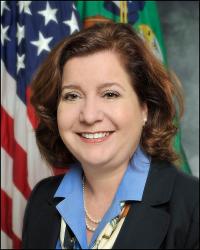Most advanced economies enjoyed a long period of low, stable inflation prior to 2021, with inflation in the U.S. actually running below the Federal Reserve’s 2% inflation target for much of the 2010s. This stability was driven in part by factors external to monetary policy, including downward price and wage pressures from globalization and de-unionization. However, the authors of a new BPEA paper, “Changing central bank pressures and inflation,” argue that emerging trends may present headwinds to central banks trying to keep inflation steady. On this episode of the Brookings Podcast on Economic Activity, paper co-author Pierre Yared of Columbia Business School speaks with Brookings Senior Fellow Don Kohn about the new research and its implications for policymakers.
Transcript
[music]
EBERLY: I am Jan Eberly, the James R. and Helen D. Russell Professor of Finance at Northwestern University.
STEINSSON: And I’m Jón Steinsson, Chancellor’s Professor of Economics at the University of California, Berkeley.
EBERLY: We’re the coeditors of the Brookings Papers on Economic Activity, a semiannual academic conference and journal that pairs rigorous research and real time policy analysis to address the most urgent economic challenges of the day.
STEINSSON: And this is the Brookings Podcast on Economic Activity, where we share conversations with leading economists on the research they do and how it will affect economic policy.
Prior to the last few years, the U.S. and most other advanced economies had experienced a very long period of low and stable inflation. Today’s episode will focus on how some of that success may have been due to lucky trends, rather than only good policy with a discussion of the new paper, “Changing Central Bank Pressures and Inflation,” by Hassan Afrouzi of Columbia University, Marina Halac of Yale University, Kenneth Rogoff of Harvard University, and Pierre Yared of Columbia Business School. Pierre will be joined by Brookings Senior Fellow Don Kohn, who is also one of the discussants of this paper.
EBERLY: The period of low and stable inflation that Jón referred to could be viewed as a success of monetary policy, both in implementation and in building credibility. But economists, including these authors, point out that low inflation has also had structural tailwinds, support from globalization, and distribution of a global supply chain—low cost imported goods, for example—plus favorable demographics and moderate fiscal policy. The question they raise is whether now those trends may reverse and put more pressure on the Fed and the independence it has garnered during this long, apparently successful run of low inflation.
STEINSSON: Milton Friedman famously said that inflation is always and everywhere a monetary phenomenon. But that doesn’t, of course, mean that other developments such as globalization don’t matter for inflation. As this paper emphasizes, other developments can matter, by making it easier or harder to achieve certain monetary goals, and this can affect the ultimate outcomes in a world with multiple objectives and imperfect credibility. It’s really a fascinating set of issues.
EBERLY: It certainly is. Now let’s turn it over to Don.
[2:46]
KOHN: Thanks, Jan and John. And welcome Pierre, to talk about the paper you presented at the Brookings panel. Good to have you on.
YARED: Pleasure to be here. Thank you for having me.
KOHN: So, can you briefly describe in general terms what the paper was about?
YARED: So, we did three things in this paper. The first thing we did was we illustrated a simple framework for understanding long-run inflation. And in doing that we fill the gap in the academic literature. The second thing we did was we used the framework to try to understand the disinflationary forces over the past 40 years across the world. And the third thing we did was to use the framework to explain why many of the post-pandemic developments are likely to keep inflation higher on average in the future. And this may come in the form of more frequent inflation spikes, such as the ones we recently saw.
[3:42]
KOHN: Great. So, obviously very important to understand these trends as we think about central banking and inflation going forward. So, let’s start actually with the second point you made about the downward trend in inflation over the 1980s, ‘90s, 2000s, really into COVID. Many people attribute this, at least in part, to central banks adopting 2% inflation targets, price stability mandates, and to receiving—and in many cases, Bank of England is a good example of this—new independence from interference by finance ministries and governments, giving them the ability to hit these targets. But you and your colleagues see a lot of other factors at play over this disinflationary period. What were those factors?
YARED: Well, absolutely. You’re absolutely right that the expansion of central bank independence and inflation targeting played a big role in advanced economies, as well as in emerging markets in some low-income economies. Our point is that this job of bringing down inflation and keeping it stable was made easier for central banks by some of the global forces that have helped that process along.
And in particular, we point to three factors that did this. The first is that globalization played a really big role in pushing down prices via an increase in competition. And that downward pressure on prices essentially reduced the monopoly power of domestic firms, which made it so that central banks saw smaller benefits from monetary stimulus. So, it’s really the interaction of globalization and central bank incentives that helped to reduce inflationary pressures globally. That’s one factor.
A related factor is the expansion of the Washington consensus. If you think about emerging markets, many of them liberalized their internal markets. And this also added to those downward price pressures along with globalization as I described. And in addition, many of those emerging markets also experienced fiscal consolidations as a part of that Washington consensus process. And when you see public debts decline and fiscal pressures decline, that also helps central banks in the sense that they don’t feel as much pressure to support fiscal expansions.
And a third factor I want to point to is de-unionization, particularly in advanced economies. That de-unionization put downward pressure on wages and induced more labor market competition. And with this increased competition, you have a similar mechanism where central banks feel less political economy pressure to stimulate the economy as aggressively.
[6:33]
KOHN: Interesting. So, actually your first point was about the effects of globalization on firms. And your last point was about the increased competition really for labor, an increased effective supply of labor in the global economy, especially, I would guess, as the Iron Curtain came down so middle and eastern Europe could join the global trading system. And as China joined the global trading system through the WTO, was huge effect on the effective global supply of labor.
YARED: That’s absolutely right. Now, I maybe want to mention one additional factor that plays a role in supporting this entire process, particularly in advanced economies, is the reduction in long-term real interest rates to bring down nominal interest rates close to the zero lower bound essentially help to support the central bank independence in the sense that central banks were more straight jacketed and unable to produce a lot of monetary stimulus, particularly in advanced economies in the past decade. And that also played a role in bringing inflation down.
[7:39]
KOHN: And that certainly was at play after the global financial crisis in 2007, ‘08, ‘09. I know central banks, including the Federal Reserve, struggled to get inflation back to the 2% target. So, why do you and your coauthors think the future will be different than the past? What’s changing with respect to price pressures going forward?
YARED: We actually think the future will be more similar to the distant past, in a sense that the more recent past may in fact, be more of the aberration. The more recent past was special. There were a lot of pressures that made the job of central banks easier. The more distant past has involved central banks feeling a lot of headwinds. And there are three that we point to in our paper that we see as changing, that make the job of central bankers more difficult. And let me go through them.
The first one is what is termed deglobalization, or perhaps slowdown of trade, global fragmentation of trade and capital flows along geopolitical lines, the lengthening of global value chains, particularly those to China. These are a reflection and part of post-global financial crisis trade barriers as well as rising geopolitical tensions. And the way you can think of that is really in our framework, it’s really a reversal of some of the trends that we saw before, because what this does is it reduces global competition. And now central banks face a tradeoff between succumbing to these pressures and allowing the inflation versus having more of an economic contraction in response to these inflationary pressures. So, that’s one factor: deglobalization.
Second factor is an increase in fiscal pressures across all country groups. So, if you look at current forecasts by the IMF, for example, we see fiscal pressures everywhere, not just in advanced economies but in emerging markets and low-income countries. Much of that is driven by debt overhang from the pandemic. That’s but a lot of that is also because primary deficits are forecasted to be larger.
We think that these forecasts should probably also take into account other factors that they don’t necessarily, such as the expansion of industrial policy across the world, which induces fiscal pressures, the adoption of green policies, which expands fiscal pressures, as well as the likely expansion of defense spending in light of some of the rising geopolitical conflicts. And with these fiscal pressures, there’s more pressure on central banks to accommodate fiscal policy.
[10:18]
And the last factor that I should mention is the zero lower bound on interest rate issue that I discussed. To the extent that the 2010s were really more of an aberration. It’s likely that long run, real interest rates will return to their historic trend levels. And if that happens, then that will mean that on average, nominal interest rates are higher, which means that central banks will also have more room to stimulate the economy as needed, and which will keep inflation higher on average.
I should say that we do not necessarily think that inflation is going to be higher and stable. We think that it’s quite likely that inflation comes down this time around. But we also think that the chances of inflation going back up and experiencing the type of spikes that we saw is much more likely in the face of these pressures.
[11:11]
KOHN: So, what would cause those spikes in inflation? Why do you think there’ll be more frequent spikes in inflation?
YARED: Well, part of it is that what our framework suggests is that in response to some of these pressures, to the extent that these pressures evolve over time, you should see inflation overshoot. So, what we show is that as soon as something happens, inflation jumps up immediately in response to the shock and then gradually lands back down, though it lands back down at a higher level in our framework.
And so, why is that? It’s really that in the face of something changing, whether it’s a global supply shock or something, or some response to a fiscal event of sorts, we should see inflation react in a positive manner. And what we’ve seen is a lot of surprises over the recent past in those inflation numbers coming from all sorts of different sources.
[12:06]
KOHN: Right. Certainly, the geopolitical effects, energy shocks over the last couple of years, very sadly, really undermine—.
YARED: Absolutely, absolutely. And those affect countries differently, of course. And part of what we’re talking about here is not just the U.S., but really the entire world. And many countries are highly susceptible to those shocks.
KOHN: But you and your coauthors wouldn’t argue with the basic proposition that over time the central bank can achieve whatever inflation goal it sets, would you?
YARED: We think that anything is possible if you set your mind to it. Of course, we’re working in a framework that is well known to all central bankers. We’re using the new Keynesian model in our analysis, and that is the implication of the new Keynesian model. But more practically, central bankers face all sorts of different pressures. And from a political economy perspective, achieving that is likely going to be more challenging in the future.
[13:07]
KOHN: Could you expand on that point? What are the challenges that central banks will face from a political economy perspective? We know that another paper at the Brookings panel session noted that people don’t like inflation. There was a poll of ordinary folks, they asked them about inflation. They don’t like inflation, and they dislike it pretty intensely. So, why do you think there will be pressures on the central banks to run with higher inflation?
YARED: Well, for sure people dislike inflation, but they also dislike unemployment. They dislike higher taxes, they dislike budget cuts, and they also dislike high interest rates. So, just because you dislike something doesn’t mean that you are willing to engage in the complicated tradeoffs to achieve it. And there’s really no consensus regarding the exact magnitude of this trade off, or where we would like to position ourselves on these tradeoffs.
And there’s a bit of a lag between policy choices and the ensuing inflation, as we saw with the most recent rise in inflation. And that lag means that in the short run, it can be quite tempting to focus on other policy goals once we feel like inflation has been stabilized, only to see inflation rise back up in the future.
Now in terms of political pressure, there’s no doubt in my mind that an individual central banker may be dead set on maintaining stable inflation, but that individual central banker doesn’t operate in a vacuum. There are elected representatives who can potentially replace the central banker. There are different central bankers who like to pursue different types of goals. And, you know, in some countries, central bank’s budgets as well as their mandates can be changed by elected representatives.
So, in our minds, the idea that somehow we have reached the end of history when it comes to central banking and that we have figured it all out, that proposition seems like a tenuous one.
[15:07]
KOHN: I agree with you. And I think if people think about deficits and government debt in particular, the interest payments on the government debt will eat more and more of the tax receipts, will need to be paid with more and more the tax receipts over time. So, I think the politicians will not be welcoming of the higher interest rates that might be necessary to fight those inflation spikes you were talking about.
YARED: I agree.
KOHN: So, in the paper, as you’ve mentioned several times, your model helps you understand some of these tradeoffs. Could you elaborate on that a bit? So, what was different about your model that wasn’t embedded in other models, and how does that help us understand how the shifting price pressures might play out?
YARED: Sure. And I appreciate you asking that. What we did there is we took the standard new Keynesian model, which is the workhorse model that academics and policymakers use. These models feature monopolistic firms, typically, and there’s some staggered price settings. So, prices are set and they’re sticky. And that’s how monetary policy can play a role.
What we do in our framework is we take two departures from the standard approach to this model. So, we don’t actually change the model, we just think about it differently. So, the first thing we do is we don’t linearize the economy around zero inflation. And the reason we don’t do that is pretty clear because we don’t think about a zero-inflation steady state. We’re trying to understand long run inflation. So, that’s the first thing we do.
[16:43]
And the second thing we do is we do not assume that there’s a benevolent government that commits at some initial date to an infinite sequence of future policies. And instead, we think about central bankers as having some discretion in formulating policies and central bankers who respond to economic factors.
Now, why did we do that? We think we did that second piece because for realism, because in practice, central bankers do use discretion. And the second reason we did that is more of a technical reason, which is that if you actually solve that model mathematically, you soon learn that the framework predicts zero long-run inflation and inflation that’s independent of the economic environment. So, the theory is unsatisfactory in that regard.
So, once we look at that model, which is really just a model that just did not linearize around zero inflation and a model that assumed discretion for the central bank, then what you could do is you can represent that model as a simple, long run aggregate demand aggregate supply curve, where the intersection of those two curves corresponds to the equilibrium long run steady state inflation rate and the equilibrium long run real output.
[17:55]
So, what do you get out of this? Which is your last question. What’s the purpose of all of this? Well, what this allows us to do is it allows us to examine how different economic forces would affect long run inflation through their interaction with central bank incentives and central bank discretion. So, that’s the first piece. So, we’re able to say what we said regarding comparative statics.
Second, this allows us to understand the path of inflation and output as an economy transitions from one steady state to another. So, it leads to that overshooting result that I referenced.
And then the third thing is that this can actually be quantified. So, it can help us think through how different forces would impact inflation and output, and also think through what level of commitment would be required to alter the predictions of the model that assumes discretion. It helps us to think through how difficult it would be to counteract some of these forces.
And one thing maybe I want to note relative to previous examples of models that considered central bank discretion—so, this was the literature back in the 1980s—what we have here is a situation where money is not actually super neutral in this framework, which means that inflation has long run implications for employment and output. And therefore, you can think about this framework as helping you also think through the long run relationship between employment output and inflation, which is absent in the linearized model.
[19:27]
KOHN: So, if price stability are very low, average inflation is still welfare enhancing even with the price pressures that are coming on and even given the tradeoffs that your model tells us about, what should governments and central banks be doing to reinforce the price stability goal and achieve this objective? Which in my view, helps enhance economic efficiency and productivity over time.
YARED: So, we think that in some ways we kind of know what we need to do, which is to have a very strong commitment to inflation targeting. But I think what’s challenging here is that in a type of divisive political environment that we live in, combined with all of these economic pressures from different places that we discussed, that’s much more challenging to achieve right now.
Now, that commitment to inflation targeting in our minds should probably be reinforced. And part of what our model helps you to think through is how the choice of inflation target is also related to what is typically talked about as a natural rate of output or a natural rate of inflation, because those are actually related to that level of inflation.
[20:48]
KOHN: Interesting. So, I would just add that the Federal Reserve has said it’s going to undertake a review of its framework for conducting monetary policy. It did this five years ago, and it said it would do it every five years. And I think this is an opportunity. One of the comments I made on the paper when you presented it was, I think this is an opportunity for the Federal Reserve to do what you just said, to reinforce the commitment to price stability, to explain why it’s chosen the target it has, how that’s consistent with price stability. It’s not choosing another inflation target. And to make sure that people understand that the dual mandate of the Federal Reserve, the other side of that mandate, price stability and maximum employment, that the maximum employment is consistent with the price stability and how they’re going to go about that. I think that will be helpful to public understanding and reinforcing the public commitment to price stability that we agree is so important.
This has been an interesting conversation, Pierre. Thank you for this, and I hope people understand a little better and can relate a little more to the issues you see you and your coauthors see coming forward, and then how your model and my suggestions might help reinforce the price stability mandate. Thank you very much.
[music]
YARED: Thank you very much.
STEINSSON: Once again, I’m Jón Steinsson.
EBERLY: And I’m Jan Eberly.
STEINSSON: And this has been the Brookings Podcast on Economic Activity. Thank you to our guests for this great conversation and be sure to subscribe to get notifications about new releases of this podcast.
EBERLY: The Brookings Podcast on Economic Activity is produced by the Brookings Podcast Network. Learn more about this and our other podcasts at Brookings dot edu slash podcasts. Send feedback to Podcasts at Brookings dot edu and find out more about the Brookings Papers on Economic Activity online at Brookings dot edu slash BPEA.
STEINSSON: Thanks to the team that makes this podcast possible, including Kuwilileni Hauwanga, supervising producer; Fred Dews, producer; Gastón Reboredo, audio engineer; with support from Shannon Meraw and Chris Miller in Economic Studies at Brookings. Show art was designed by Katie Merris at Brookings and promotional support comes from our colleagues in Brookings Communications.
- Listen to the Brookings Podcast on Economic Activity on Apple, Spotify, or wherever you like to get podcasts.
- Learn about other Brookings podcasts from the Brookings Podcast Network.
- Sign up for the podcasts newsletter for occasional updates on featured episodes and new shows.
- Send feedback email to [email protected].
The Brookings Institution is committed to quality, independence, and impact.
We are supported by a diverse array of funders. In line with our values and policies, each Brookings publication represents the sole views of its author(s).










Commentary
PodcastWhat global factors could make inflation less stable?
Listen on
Brookings Podcast on Economic Activity
May 23, 2024